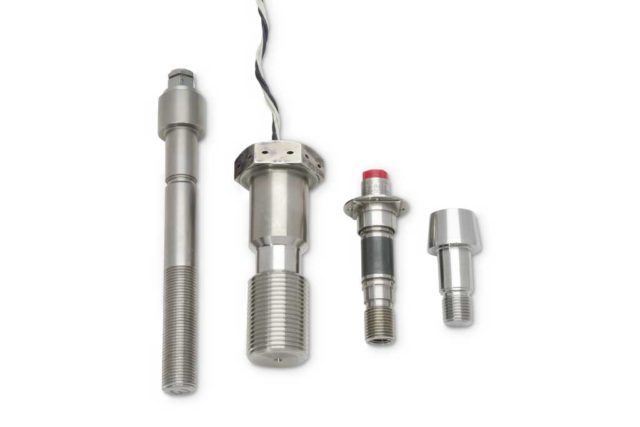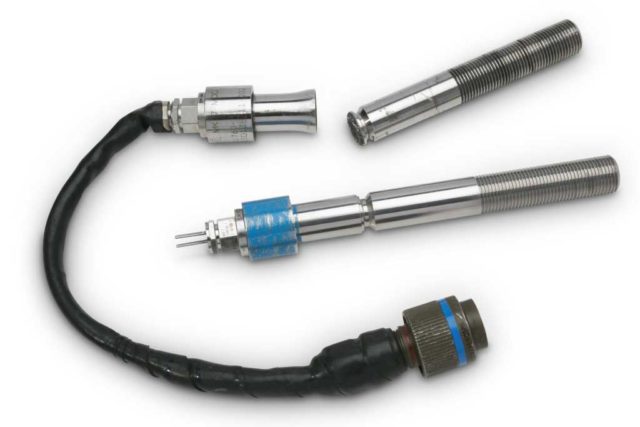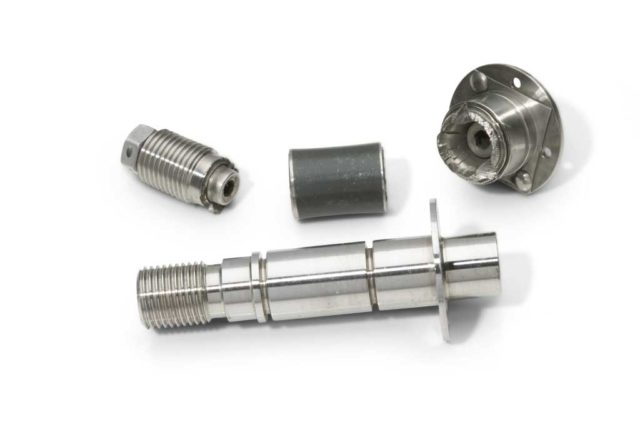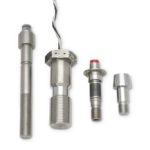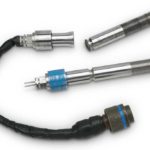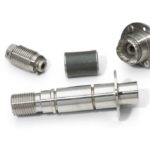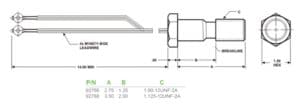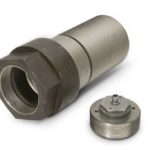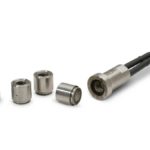Explosive Bolts
Product Description
Explosive bolts efficiently secure two objects and strategically explode, jettisoning those objects on command when commanded. These bolts initiate a perfect failure at the pivotal moment they need to. This part is designed for missile, launch vehicles, spacecraft and marine applications where rapid structure separation is demanded. Standard explosive bolts and ridge cut explosive bolts are available in a wide range of sizes, configurations and tensile capacities from as little as 200 pounds to as much as 1,000,000 pounds. As an explosive bolt manufacturer, our experts are here to support you in meeting your structural loading, envelope and environmental requirements and guide you on ways to mitigate shrapnel and products of combustion.
Key Features
- Can be removable
- Low fragmentation
- Fragmentation can be controlled
- Separate cleanly
- Immune to malfunction due to vibration
- Withstands high shock loads
- No moving parts prior to operation
How An Explosive Bolt Works
They are used for fastening mating components or devices together to then allow rapid structural separation when commanded. Also known as pyrotechnic fasteners, explosive bolts feature machined geometries to control the separation location and breaking strength. An explosive charge, located within a machined cavity in the bolt, or externally for Piston Bolts (Propulsive Bolts), provides the energetic stimulus required to cleanly separate the bolt at the predetermined break plane.
By design, an explosive bolt will separate at a specified break plane controlled by the machined geometries. Surprisingly, there are four different types of bolts. They can be categorized into two: explosive bolts and separation bolts. The difference being whether you use explosive detonating material or a pyrotechnic pressure generating material. Another distinction is that with explosive bolts, the combustion gases are vented when the bolt separates whereas with Separation bolts the combustion products can be contained. The selection, of course, will vary depending on the application requirements. A standard explosive bolt simply uses enough explosive charge, pressed into a counterbore of the bolt. When fired, the detonation exceeds the bolt strength.
There are a large range of explosive and separation bolt sizes and strengths. From a design consideration, for explosive bolts to break, there must be room for the shank of the bolt to expand within the area above the break plane.
Our Explosive Actuated Bolts are designed to separate cleanly along a predetermined fracture plane. An explosive charge, located within a cavity in the bolt, provides the energetic stimulus required for bolt fracture. Explosive bolts are supplied in a wide range of sizes and configurations tailored to suite structural loading, envelope and environmental requirements. The bolts we supply range in tensile capacity from as little as 1400 pounds (.25 inch diameter) to as much as 557,000 pounds (5.75 inches diameter).
An explosive charge within the center bore of the bolt provides the energetic stimulus required to fracture the bolt. Explosive gases are vented.
For standard explosive bolts, there is some fragmentation, however, the mating structure contains much of the bolt.
The head of the bolt remained with the structure due to the expansion. Standard Pressure Actuated Pyro Bolts provide maximum tensile and fatigue strength for the available envelope at minimum cost. Tensile, shock and hoop stresses developed from an internal detonation cause failure of the bolt along predetermined stress riser at the separation plane. Shrapnel and products of combustion are not contained.
► Standard Explosive Bolt: enough explosive charge to fracture the bolt
If you need the bolt to be removable, this can be accommodated if you allow the expansion to occur inside the bolt outside diameter, for example, you have a 1 3/8 bolt but the shank at the break plane location is only 1 inch in diameter.
A ridge cut bolt is similar in construction, however, a design feature of the bolt allows for the detonation shock wave to reflect on itself and that constructive interference exceeds the bolts tensile strength, breaking the bolt. This design method virtually eliminates fragmentation and allows for bolt expansion. Ridge-Cut Explosive Bolts employ shock wave mechanics to realize reduced shrapnel generation while maintaining high tensile strength. Explosive gasses are vented. The explosive load is pressed directly into the bore of the bolt. Shock waves emanating from the detonation pulse reflect from external surfaces to intersect and create tensile fracture along a conical path from the base of the bore to the edge of the notch on the outside diameter of the bolt.
► Ridge-Cut Bolt: employ shock wave mechanics to realize reduced shrapnel generation
Energy Inputs
Initiation of Explosive and Separation Bolts. There are three ways; electrical, explosive transfer line, and mechanical. One might argue that there are only two ways because the explosive transfer lines are functioned either electrically or mechanically.
Electrical Initiator or Detonator
Most electrical initiators/detonators are functioned using 3.5 amps which is in accordance with MIL specs and standards. These devices have also been tested as high as 22 amps. Cap discharge methods can be used as well as long as enough energy is provided.
Explosive Transfer Line
Different transfer lines can be used (det cord, Rapid Deflagrating Cord, shock tube, etc.) The transfer line end-tip is the important feature and will need to be matched with the bolt design for proper detonation transfer.
Mechanical Initiation
Mechanical initiation can be achieved with a lanyard type device or a T-handle device. T-handles will use a transfer line to mate with the bolt downstream of the handle.
Redundancy
Not all applications require redundancy.
Electrically, initiators and detonators can use a second bridge wire. A single firing circuit could fire both bridges or two independent firing circuits could be connected to each of the separate bridge wires.
Similarly, two separate initiators or detonators could be used. Either one or both will function the bolt.
Two inputs/One Break-plane
There are opposing initiators, one at each end of the bolt with a single break plane. Either one or both, when functioned, will break the bolt at the
same break plane.
Two Inputs/Two Independent Break-planes
There are opposing initiators at the ends of the bolt, but in this case the two break-planes are independent of each other. They can be functioned separately or at the same time.
Two Inputs / Two Simultaneous Breakplanes
With opposing inputs, but either input or both will break the bolt in both locations. This is especially useful in hinge designs. This particular bolt is used on a hinge, and when fired, releases the aircraft canopy during a pilot emergency egress.
Applications
Pyrotechnic Explosive Bolt designs are qualified and used for stage separation and release device for missile applications including Standard Missile 3, Range Extending Munitions Aero Packages, Solid Rocket Booster and main tank separation for the NASA shuttle, parachute deployment and mechanism release for weapon system.
Below we have some example applications utilizing the two different explosive bolt types. The loads shown are the proof load requirements and the design margins are typically 1.25x to 2x.
Standard Explosive Bolt
Helicopter emergency release using a single bolt with a dual bridgewire initiator.
Emergency Release 1.375″ 90,000 lb
Parachute Release 1/2″ 18,000 lb
The submunition on the left uses five single bridgewire initiated bolts and redundancy was not required in this case. One bolt releases the parachute from the top canister and one each to release the four projectile skeets on the sides.
Ridge Cut Bolts
In these two examples, ridge cut design was used in a Marman clamp (similar to a V-Band) to restrain and then to release a missile prior to launch.
Common Design Criteria and Test Method Defining Documents
- MIL-C-83124 Detail Specification Initiators, Electric, General Design Specification
- AIAA S-113 Criteria for Explosive Systems and Devices on Space and Launch Vehicles
- MIL-HDBK-83578 Criteria for Explosive Systems and Devices on Space Vehicles
- MIL-D-21625 Design and Evaluation of Cartridges for Cartridge Actuated Devices
- MIL-DTL-23659 Detail Specification Initiators, Electric, General Design Specification
- MIL-STD-810 Environtmental Engineering Considerations and Labratory Tests
- MIL-STD-1516 Electroexplosive Subsystems, Electrically Initiated Design Requirements and Test Methods
- MIL-STD-1576 Electroexplosive Subsystems Safety Requirements and Test Methods for Space Systems
- MIL-STD-331 Fuze and Fuze Components, Environmental and Performance Tests
- MIL-STD-202 Test Methods for Electronic and Electrical Component Parts
- MIL-STD-466 Electromagnetic Environmental Effects, Requirements for Systems
**Some of the noted documents are cancelled for new designs but are still readily used in the industry**
Specifications
- Input Stimulus, Typical
3.5 amp (when electrically initiated)
TLX or SMDC input
4.5 AMP/4.1 millisecond - Tensile Strength
Up to 550,000 lbf - Operating Temperature
Designs as low as -65 °F and up to +270 °F - Separation Time, Typical
<10 milliseconds after application of All-Fire input stimulus
<5 milliseconds at greater currents - Applicable Specifications
Qualified for:- MIL-DTL-23659 Appendix A
- Mil-C-83124
- NASA NHB5300.4(1C)
- Mil-STD-1512
- Hermesticity (pre-function)
Designs that comply with 1 x 10-6 cc He/sec at 1 atm
Interface
Explosive bolt sizes and configurations can be tailored to meet structural loading, envelope and environmental conditions requirements for specific applications. The below technical envelope is for our 92766 Explosive Bolts. Another common P/N is 851542.
Configuration Envelope:
- Thread Size
- Initiation Type
- Overall Length
- Total Mass
- Material
- Hex Size
- Break Location
- Break Strength
- Detonation Means
- Non Detonation Means
- Electrical
- Non Electrical
Booster Charge:
- Pyrotechnics
- Propellants
- (Non-detonating)
Environment Capabilities:
- Max Temperature
- Min Temperature
- Max Shock Levels
- Max Vibration
- Acceleration Limit
- Max Storage Temperature
- Salt Fog & Humidity
Ignition Considerations
- Firing Current (AC-DC)
- Constant Current
- Capacitance Discharge
- Low Voltage Ignition
- High Voltage Ignition
- Explosive Transfer Lines
- SMDC, FCDC (detonating end tips)
Electric Properties
- Insulation Resistance
- Dielectric Withstanding Voltage
- Circuit Resistance
- ESD Protections
Performance Characteristics
- Fragmenting Break Plane
- Rigid Cut Break Plane
- Multiple Break Planes
- Clean Separation
Output Charge
- Secondary High Explosives
- Examples: RDX, HMX, HNS, PETN
- (Detonating)
Intermediate Charge
- Primary High Explosives
- Lead Azide
- DBX
- (Deflagration to Detonation)
FAQ's
-
What's the difference between explosive and separation bolts?
The difference between explosive bolts and separation bolts is you use either explosive detonating material or a pyrotechnic pressure generating material.
-
What causes a bolt to fail at the separation plane?
For an explosive bolt the internal detonation exceeds the bolt strength.
-
What is a pyrotechnic explosive bolt?
Also known as pyrotechnic fasteners these are machine geometries on a bolt which control the separation location and breaking strength when initiated.
-
What is the thread size?
Multiple sizes are available based on your needs.
-
What is the tensile strength?
Designed to match the application.
-
What is the initiation method?
Electrical or mechanical.
-
Is there fragmentation?
No.
-
What is the operation method?
Pyro hot gas or cold gas.
